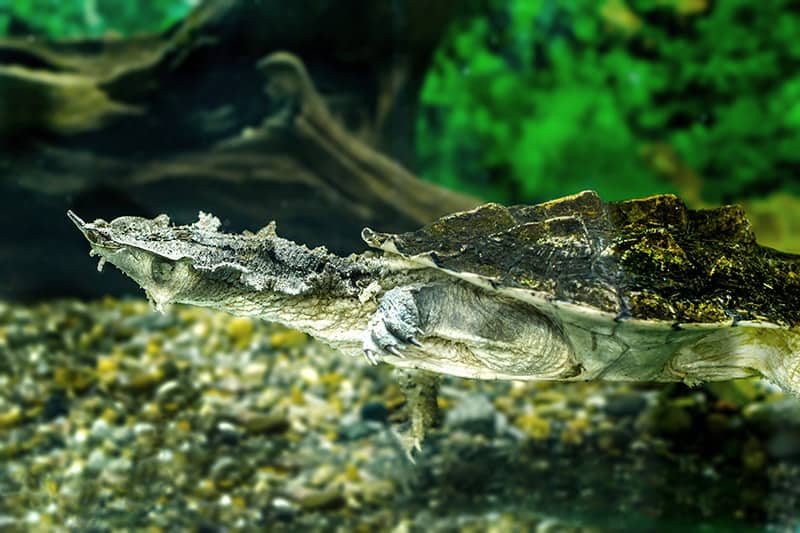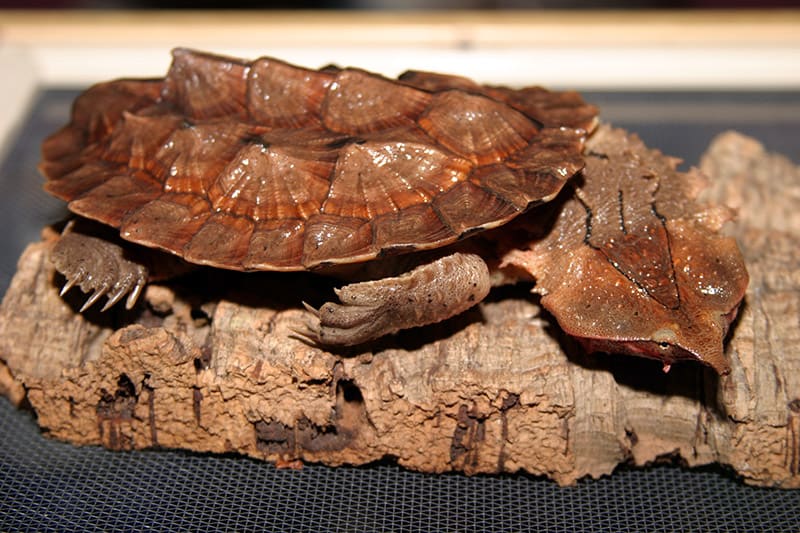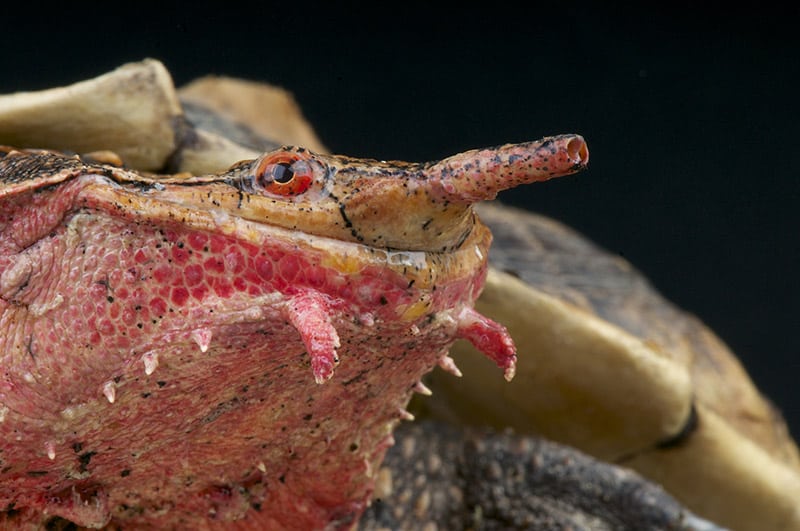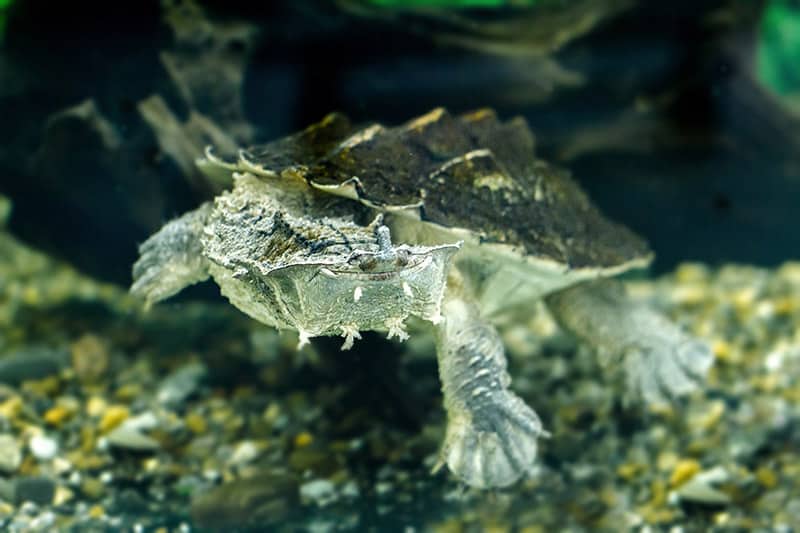The ‘leaf mimicing’ Matamata is truly one of the world’s most unusual turtles!
This large South American species, the Matamata Turtle, is a wonder to watch. Though it is not a pet to be handled, its interesting lifestyle and bizarre appearance make it perfect for a beautiful display.
The Matamata Turtle gets quite large, up to 18″, and almost exclusively eats live fish. It will need a large warm environment and close attention paid to its water conditions. Though they can be quite hardy, if the water quality is not well maintained they can succumb to illness so be sure to include a good filtration system. A wonderful display replicating its natural Amazon River home, gentle water movement along with some plants and driftwood will be a delight for both you and your turtle.
- For more information see: Selecting and Caring for Your Turtle or Tortoise
Scientific Classification
| Kingdom: | Animalia |
| Phylum: | Chordata |
| Class: | Reptilia |
| Order: | Testudines |
| Family: | Chelidae |
| Genus: | Chelus |
| Species: | fimbriatus |
Distribution
Matamatas are found in the Amazon River and its tributaries in Peru, Venezuela, Guiana, and Brazil.
Status
These turtles are not listed on the IUCN Red List.
Description
The Matamata Turtle is a large and very amazing looking turtle. It is flattened with a rugose shell and exciting flaps of skin that make it one of the most well-camouflaged species in the world. Matamatas reach a large adult size of 18″ (46 cm) or more.

Care and Feeding
Matamata Turtles are carnivores and feed almost exclusively on live fish. Offer them a variety of prey such as goldfish, platies, mollies, minnows (shiners), Gambusia, guppies, and even earthworms.
Environment
The Matamata Turtle grows large and imported specimens of 17-18″ are not uncommon. Obviously, these large specimens require large enclosures. Matamatas, however, are not active hunters and like the Alligator Snapping Turtle, they need less space than a large, active species. Small to medium specimens (6-10″) can be kept successfully in a 40- to 60-gallon aquarium.
Water quality is the key to keeping this species successfully in captivity. The water’s pH should be low (5.0 to 5.5) and the addition of tannins from peat, leaves, and sphagnum moss in the water adds to the development of a perfect Matamata enclosure.
Water temperature should be warm (78 to 82 F) and maintained year round. It is felt by several long-term Matamata keepers that the surrounding room in which their enclosure is located should also be maintained in the 80 to 85 F range to avoid having the turtles breathing in cool air and causing potential respiratory problems.
They require moderate to heavy filtration. We do, however, suggest a break in any falling water. A driftwood stump or rock will keep the water from falling and splashing too violently into the enclosure, more closely resembling the quiet, slow-flowing inlets of its natural habitat.
A Matamata enclosure should have a sandy substrate to prevent abrasions to the turtle’s plastron and to act as an anchor for plants. Decorations can include driftwood and a variety of submerged and floating aquatic plants. As Amazon River dwellers, there is certainly no shortage of plants from which to choose. (Most tropical fish and plants in the pet trade are of Amazon River origin.)
Lighting should be provided by UVB-emitting bulbs in shop light fixtures. Even though these turtles do not bask, offer a 100-watt spotlight over one end of their enclosure to add some warmth and to provide better viewing.

Handling
As with all aquatic turtles, we suggest that keepers keep handling to a minimum. They can be handled when their enclosures are cleaned or when they are moved from indoor enclosures to outdoor enclosures, but they are definitely not hands-on pets.
Young Matamata Turtles are very secretive and delicate and seem to be especially stressed when handled out of water. We do suggest, however, that a keeper pull their turtles out of their enclosures once a month to check for any signs of health-related problems.
Breeding
There are few reported cases of Matamata Turtles breeding in captivity. Babies from imported females that have dropped eggs during importation have entered the hobby occasionally, but most young Matamatas have been smuggled into the country in shipments of tropical fish. At the time of writing, there are several keepers in the United States incubating Matamata eggs that were obtained from large, imported females (probably injected with oxytocin). Time will tell if this controversial method for obtaining eggs has been successful in increasing the captive population of Matamatas.
Hatchling and small Matamatas are sensitive to their captive conditions. Care must be taken that their needs are met almost precisely. They require warm, clean water with a low pH and with plenty of tannins. The addition of live plants to their captive environment seems to be important as well.
It is also apparent that small Matamatas should be set up in their enclosures and not handled very much. Many young turtles will refuse to feed for long periods of time after they are imported, shipped, or disturbed by extensive handling. When established in a secure enclosure with the proper conditions, young Matamatas will begin feeding on a variety of live fish. Offer them guppies, assorted livebearers, goldfish, rosy reds, and others.
Ailments / Health Problems
- Poor Water Quality: Most problems with captive Matamata Turtles are water quality related. Unclean water or water with high pH are common poor husbandry offerings. Matamatas are often imported with injuries to their feet or skin, especially the delicate flaps that aid in their astonishing camouflage. If kept clean, these areas will not regrow, but will heal quickly.
- Parasites: Matamatas have proven somewhat difficult to deparasitize as they tend to eat only live prey. We have had success with injecting a dose of Panacur® into a dead minnow or goldfish and wiggling the fish in front of the turtle or allowing it to float down in front of a turtle that is eager to feed. Though difficult, imported specimens must be deparasitized and acclimated to be established and bred in captivity.

Availability
A few times a year, dozens of young Matamatas are illegally smuggled into the country with shipments of tropical fish from South America. These small Matamatas hit the reptile market and are quickly bought up by unaware turtle fanciers.
Recently, the first shipments of legally farm-raised specimens have entered the U.S. Matamatas have only been bred in captivity once or twice in the past twenty years. These animals did not make it into the pet trade as they were zoo breedings or were bred by individuals who were not interested in placing their baby turtles into the pet trade.
Hopefully, some of the larger specimens that have been set up for breeding will begin producing these wonderful leaf-mimicking babies in the near future.
Featured Image Credit: Artex67, Shutterstock
